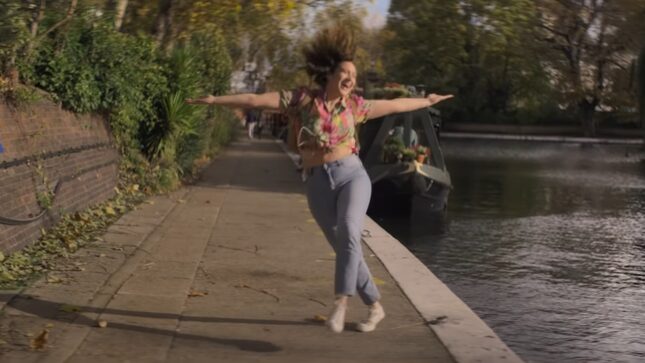TV Should Make More Shows Like Rose Matafeo's Starstruck
The HBO Max comedy is the only honest reimagining of the rom-com trope and I want to watch it on loop
EntertainmentTV

About halfway through Starstruck, BBC and HBO Max’s comedy from rising comic Rose Matafeo, I decided it was the best thing I’d ever watched, and immediately craved more of it. What was this new sensation I felt—pleasure, excitement even? I can’t pinpoint the last time television had spurred such raucous feelings inside me.
The premise of Starstruck, which premiered on HBO Max earlier this month, is quite simple. Jessie (Matafeo) works a variety of odd jobs in London: movie theater clerk, nanny, and, later, flower delivery person. At a club on New Year’s Eve, she has a chance encounter with an incredibly hot man in the men’s restroom, Tom (Nikesh Patel), who lightly roasts a tipsy Jessie. They later find themselves at the bar, alone, minutes to midnight. The ball drops and so does their sexual tension. At his gargantuan flat the next morning, Rose discovers that Tom is actually an extremely famous action movie star. Hijinks ensue!
Starstruck’s premise isn’t particularly innovative. Romance writers have, for years, retread similar ground: Regular woman unexpectedly falls for the famous movie star, or powerful CEO, or prince, or alien overlord. The trick here is not necessarily diverging from a particular format, it’s what those writers do with the playgrounds they work inside. Matafeo excels in this regard.It’s clear that Matafeo is a rare talent. A writer and actor who has married—excuse the romance pun—physical comedy and stellar quips. Each episode practically zooms along, aided by physical gags and nuclear dialogue from its two leads. Jessie is prideful and a bit delusional at times. After fucking some guy on his houseboat, she skips down a promenade to the sweet tunes of “Return of the Mack.” After a particularly nasty fight with Tom, she evicts everyone at the theater cafe who claims to be a screenwriter, sick of anything that even reminds her of the incredibly famous man blowing up her cell phone. Tom, meanwhile, is delightfully affable. Neither are particularly good people. They lie to each other and manipulate the people around them. At one point, Tom stuffs Jessie in the shower of his hotel room at a movie premiere after his beautiful co-star comes crashing through the door drunk, wondering if the two were going to sleep together again. Both Jessie and the co-star fall asleep while Tom sits pensively on the floor, wondering how he possibly put himself in this predicament.
It also feels dishonest to not mention that Jessie, unlike Tom’s fictional co-star, is neither white nor impossibly thin. But unlike other romance media of late, both Matafeo and her cinematographers never dwell on this unspoken understanding. There are no scenes where Jessie mocks herself in the mirror. She never overcomes the criticism of another man, learning only to love herself and her body after a dance sequence and scene in which she strolls down the street in a crop top while everyone around her gawks, a trope beloved by rom-coms. In a particularly memorable scene, the photographers outside Tom’s house believe her to be a maid. But she moves right along, boasting in a later scene about the many sexual conquests she’s had that month, texting both Tom and a Soundcloud DJ she keeps on retainer for the dry months.
As for Tom and Jessie as a pairing, Matafeo and Patel are among those once-in-a-generation couplings: Harry and Sally, Katie and Hubbell, Stella and Winston. Their chemistry is magnetic and practically melts the television every time they’re onscreen together, their body language and conversations dripping with anticipation. In more typical romance beats, Tom says he likes that his conversations with Jessie are interesting; he even tells her that she is the most “stressful person I know.” The worst sorts of rom-coms try to smash a generic everywoman and handsome guy-dude together like jagged, ill-fitting Lego bricks—Starstruck refreshingly does the opposite.

Other bright spots include Karen Maine’s excellent television directorial debut, having previously worked on Obvious Child and Yes, God, Yes. Her choice of shot length and lens type bring about a dreamy, almost surrealist quality to Jessie’s exploits. There’s a slight distortion and warping at the edges of the screen, as if all of reality has wrapped itself around this once-in-a-lifetime encounter, and Tom and Jessie are the only people left on the planet. It’s particularly noticeable when the characters are indoors, the bubble-like effect drawing all attention to the characters and dialogue, like a stage play. Jessie’s best friend Kate (Emma Sidi) is also an exceptional foil, squealing in delight around Tom, incapable of “acting normal,” as Jessie begs her to. Minnie Driver is also here for one episode, an added bonus. The costumes, likewise, are delightfully weird and colorful, Rose’s immediate world brimming with life and, courtesy of Kate’s flower shop, bountiful greenery.
A part of me doesn’t want it to end. I’d like to live inside Matafeo’s interior world just a tad bit longer. It’s warm, filled with laughter, and just a tad bit stressful. There’s nothing else like it on television.